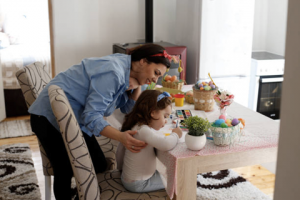 A loss is a journey that an entire family walks along. During this time, families experience a wide range of emotions which may include feelings of grief, isolation, confusion and anger. These are not only experienced by adults but can be experienced by the little people in the family too. Studies have shown that even infants and toddlers react to loss. That being said, discussing loss, death and dying can be a scary topic for adults to have with children. How do you start? What do you say? Where the thought process may be along the lines of “protecting our children”, the lack of, or avoiding the conversation altogether can create a sense of confusion and isolation for children.
A loss is a journey that an entire family walks along. During this time, families experience a wide range of emotions which may include feelings of grief, isolation, confusion and anger. These are not only experienced by adults but can be experienced by the little people in the family too. Studies have shown that even infants and toddlers react to loss. That being said, discussing loss, death and dying can be a scary topic for adults to have with children. How do you start? What do you say? Where the thought process may be along the lines of “protecting our children”, the lack of, or avoiding the conversation altogether can create a sense of confusion and isolation for children.
You are not alone. Your village is here to support you. In this blog Faiza Ali, The WOMB’s Child Life Specialist highlights her key thoughts and considerations when talking to children about a death and the developmentally appropriate support you can provide at home!
To preface this discussion, it’s important to know that there’s no right answer. As unique as we are as people, our losses are the same. Death is a difficult concept to comprehend let alone trying to figure out how to explain it while one is grieving. That being said, there are ways of providing supportive discussions for children in the family. Knowing this, it is essential to understand child development and how it impacts the understanding of death, ways they may react and coping strategies to support them.
Talking to your child
When sharing death with children, know that this is a topic that will be discussed over and over again. Children process through explanation, clarification and play. You may start noticing younger children drawing, painting or role-playing death in their games while older children may come to you with lots of “whys?” and repeat conversations you’ve had previously. Know that their curiosity comes from a place of learning and understanding. Their brains are trying to comprehend the loss from a variety of perspectives including a “what now?” lens.
As caregivers, take a moment to care for yourself. As you grieve the loss in your family, you are also supporting your child(ren)’s grief. Sharing small and manageable amounts of information can help your child’s understanding of the loss and give you time to process your thoughts and discussions. Be sure to engage in some sort of relaxation, meditation and self-care before starting this discussion.
Time and Place
While there is never a perfect time or place for these discussions, there are factors that you can consider when creating the space to have this discussion. Consider a time when you are able to spend quality time without interruptions. This could be a weekend morning after breakfast with a park day planned in the afternoon or an unscheduled afterschool night with the possibility of family cuddles before bedtime. What you want to ensure is that your child has the opportunity to ask questions and can sit with you to address their thoughts and feelings.
Introducing death

Talking about death means sharing concrete language without any euphemisms. A euphemism is an abstract expression that is commonly used when addressing someone who has died. You may have heard “Grandpa was sick and passed away” or “We lost the baby today” or “Lucky, our family dog has gone to sleep”. The problem with this terminology is that is can be extremely confusing for children. “Grandpa passed? Where? Is he passing by the house right now?” or “Lost the baby? Go find her then!” or “Lucky is sleeping? That’s okay, I’ll wake her up in bit!”. When concrete language is used, there is a clear understanding of what it means to die and why that impacts the family the way it has. When explaining death to children, address key factors that differentiate one from being dead vs alive.
“____has died. When someone dies their heart stops beating and their lungs stop breathing. They cannot see, feel, touch or smell. They do not feel anything and they are not in any pain. They may not be here with us physically, but we will always be connected through our love”.
The Invisible String is an incredible resource for families to use. The premise of this book is around staying connected with loved ones when you are apart. This audio book can be a great introduction to connection activities and discussing unique ways your family will honour the loss.
Check in

Check in with yourself. Allow yourself to process. Provide opportunities for check ins and clarification with your child to let them know they are welcome to discuss their feelings with you anytime. After a certain age, children innately try and protect their parents. They may be closed off or withhold their thoughts in fear of upsetting you or your partner. Sharing that even adults get sad can make a world of a difference for children. These check ins can look like a nightly “tell me about your day?” or a planned day in the week where you sit down with your child for a dedicated period of time. Choose your check in time based on your grief process and what works for your family.
Want more information on your child’s age and stage and how to support them? See below to get tips and pointers to help our little person through their grief process.
 Faiza Ali is the Child Life Specialist at The WOMB. She supports families in the Burlington, Milton and Oakville areas in-home, through community workshops, and by virtual consultation. Contact Faiza at The WOMB Milton to learn more about Child Life support/
Faiza Ali is the Child Life Specialist at The WOMB. She supports families in the Burlington, Milton and Oakville areas in-home, through community workshops, and by virtual consultation. Contact Faiza at The WOMB Milton to learn more about Child Life support/
Newborns, Infants and Toddlers
Infants and toddlers do not understand the concept of death or loss. However, they do respond to changes in their environment and pick up on the disruption in routine, time away from their primary caregiver and emotional disturbance around them. This age group experiences any separation as a feeling of loss. While they may not fully be able to express their grief, certain behavioural changes may be displayed to showcase the distress that they are feeling.
How to support your child:
- Hold and cuddle more – keep them close
- Keep to routines if possible
- Be calm around them and speak calmly to them
- Provide comforters, favourite teddies or blankets etc
- Try and maintain a consistent caregiver
Pre-schoolers and young school age (3-5)
This young age group struggles to understand the permanence of death. Topics of death/dying/ loss may have been exposed to them through movies and TV shows. You may observe them asking a lot of questions about death but not fully comprehending the concept. Developmentally, children are at the stage of “magical thinking”. This means that ideas are driven by fantasy and/or they make connections that aren’t related. An example of this could be thinking that a person who has died can come back to life or unrealistic connections such as “I said I didn’t want to share my room that’s why the baby died”.
How to support your child:
- Provide information and honest answers to questions
- Keep routines
- Talk about who is looking after them and keeping them safe
- Support them with touch – hugs, encouragement, holding their hand etc
- Keep close to familiar adults (you may notice anxiety even when being left with familiar adults)
- Honestly explain death as a part of life using what they can see (plants/insects)
- Read books about death and grief
- Use words that describe feelings
- Create a memory box together
School-age and pre-teens (6-12)
In this developmental stage, children are starting to become complex thinkers and can understand the permanence of death and what death means for them individually. They are starting to understand that someone who dies cannot come back to life, however, clarifications may be needed to address misconceptions around the “feelings” of the deceased, “Are they cold? Hungry?” etc. Understanding death can also cause anxiety for children in this age group for their own well-being as well as other loved ones.
How to support your child:
- Reassure your child they are safe and say who is looking after them
- Keep routine and normal boundaries around expected behaviour
- Keep separation from loved adults and caregivers to a minimum
- Make time to listen to their thoughts and questions and answer honestly
- Talk about death being a part of life
- Make a memory box, scrap book, photo album together
- Encourage play – this is a natural form of communication and an opportunity to process what has happened
- Encourage exercise
Teenagers (13+)
By this age, teenagers have a comprehensive understanding of death and understand that death is a part of life. This age group is exposed to death in a variety of circumstances including watching/listening to the news, hearing a peer’s experience of death and potentially experiencing the loss of a pet (fish, dogs, cats, etc).
While death as a concept is understood, this age group is experiencing significant emotional and physical changes in their life. The added intensity of a loss without discussion may cause confusion, isolation, risky behaviour and/or anxiety.
How to support your child:
- Include them, be honest about what is happening
- Talk about the death together
- Be willing to listen and give regular opportunities to be available to answer questions
- Acknowledge and share your feelings and let your teenager know that you understand it is hard for them
- If they don’t want to talk to you, leave helpful information around the house
- Talk about grief, what is normal and how everyone grieves differently
- Ask for support from extended family, friends, teachers, GP – ask other adults to be available and check in with your teenager
- Keep routines, where possible
- Avoid expectations of adult behaviour
- Praise and encourage them
- Seek professional help if you are concerned





